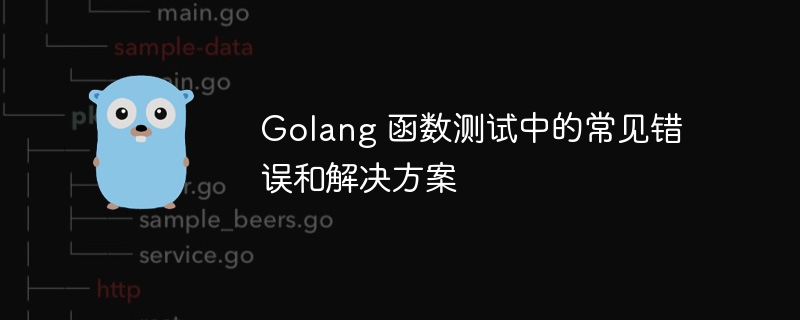go 语言函数测试的常见错误有:缺乏测试用例分组:使用 t.run() 分组以提高可读性。未检查测试失败原因:验证 got 与预期值和错误信息是否匹配。测试依赖性缺乏隔离:使用 mock 或测试 double 隔离依赖项。测试结果无法复用:使用测试表存储和重用测试数据。未覆盖所有代码路径:利用覆盖工具查找未覆盖的代码。通过遵循这些指南,可以提高测试质量和代码可靠性。

Go 语言函数测试中的常见错误及解决方案
在 Go 语言中编写函数测试时,可能会遇到一些常见的错误。本文将讨论这些错误并提供解决方案,通过实战案例帮助你避免或解决这些错误。
错误 1:没有使用 t.Run() 分组测试用例
立即学习“go语言免费学习笔记(深入)”;
解决方案:
func TestSampleFunction(t *testing.T) {
tests := []struct {
input []int
output int
}{
{[]int{1, 2, 3}, 6},
{[]int{-1, 0, 1}, 0},
}
for _, tc := range tests {
t.Run(tc.input, func(t *testing.T) {
got := SampleFunction(tc.input)
if got != tc.output {
t.Errorf("Expected %d, got %d", tc.output, got)
}
})
}
}错误 2:未检查测试失败的原因
解决方案:
func TestSampleFunction(t *testing.T) {
tests := []struct {
input []int
output int
wantErr error
}{
{[]int{1, 2, 3}, 6, nil},
{[]int{}, 0, errors.New("empty slice")},
}
for _, tc := range tests {
t.Run(tc.input, func(t *testing.T) {
got, err := SampleFunction(tc.input)
if err != nil && tc.wantErr != nil {
if got != tc.output || !errors.Is(err, tc.wantErr) {
t.Errorf("Expected %d, got %d; expected error %v, got %v", tc.output, got, tc.wantErr, err)
}
return
} else if err != nil && tc.wantErr == nil {
t.Errorf("Unexpected error: %v", err)
} else if err == nil && tc.wantErr != nil {
t.Errorf("Expected error %v, got nil", tc.wantErr)
}
})
}
}错误 3:测试依赖性之间缺乏隔离
解决方案: 使用 mock 或测试 double 来隔离测试依赖项:
func TestSampleFunction(t *testing.T) {
// 创建一个 mock 依赖项
mockDep := new(MockDep)
t.Run("success", func(t *testing.T) {
// 将 mock 依赖项传递给函数
got := SampleFunction(mockDep)
// 验证 mock 依赖项的行为
if mockDep.CallCount != 1 {
t.Errorf("Expected mockDep to be called once, got %d", mockDep.CallCount)
}
if mockDep.LastInput != input {
t.Errorf("Expected mockDep to be called with input %v, got %v", input, mockDep.LastInput)
}
})
}错误 4:测试结果无法复用
解决方案: 使用测试表来存储和重用测试数据:
var sampleTestTable = []struct {
input []int
output int
}{
{[]int{1, 2, 3}, 6},
{[]int{-1, 0, 1}, 0},
}
func TestSampleFunction(t *testing.T) {
for _, tc := range sampleTestTable {
t.Run(tc.input, func(t *testing.T) {
got := SampleFunction(tc.input)
if got != tc.output {
t.Errorf("Expected %d, got %d", tc.output, got)
}
})
}
}错误 5:未覆盖所有代码路径
解决方案: 使用覆盖工具(例如 coverage)来识别未覆盖的代码:
go test -coverprofile=coverage.out
然后查看覆盖报告以查找未覆盖的代码路径。
遵循这些指南,你可以避免或解决 Go 语言函数测试中的常见错误,提高测试质量,为你的代码库提供更高的信心。
以上就是Golang 函数测试中的常见错误和解决方案的详细内容,更多请关注php中文网其它相关文章!

每个人都需要一台速度更快、更稳定的 PC。随着时间的推移,垃圾文件、旧注册表数据和不必要的后台进程会占用资源并降低性能。幸运的是,许多工具可以让 Windows 保持平稳运行。




Copyright 2014-2025 https://www.php.cn/ All Rights Reserved | php.cn | 湘ICP备2023035733号